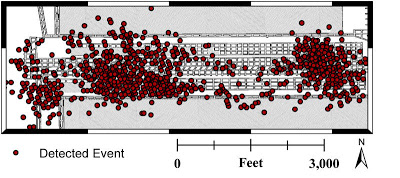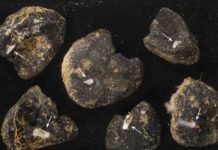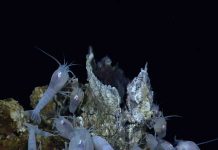
A new University of Utah study has identified hundreds of previously unrecognized small aftershocks that happened after Utah’s deadly Crandall Canyon mine collapse in 2007, and they suggest the collapse was as big — and perhaps bigger — than shown in another study by the university in 2008.
Mapping out the locations of the aftershocks “helps us better delineate the extent of the collapse at Crandall canyon. It’s gotten bigger,” says Tex Kubacki, a University of Utah master’s student in mining engineering.
“We can see now that, prior to the collapse, the seismicity was occurring where the mining was taking place, and that after the collapse, the seismicity migrated to both ends of the collapse zone,” including the mine’s west end, he adds.
Kubacki was scheduled to present the findings Friday in Salt Lake City during the Seismological Society of America’s 2013 annual meeting.
Six coal miners died in the Aug. 6, 2007 mine collapse, and three rescuers died 10 days later. The mine’s owner initially blamed the collapse on an earthquake, but the University of Utah Seismograph Stations said it was the collapse itself, not an earthquake, that registered on seismometers.
A 2008 study by University of Utah seismologist Jim Pechmann found the epicenter of the collapse was near where the miners were working, and aftershocks showed the collapse area covered 50 acres, four times larger than originally thought, extending from crosscut 120 on the east to crosscut 143 on the west, where miners worked. A crosscut is a north-south tunnel intersecting the mine’s main east-west tunnels.
In the new study, the collapse area “looks like it goes farther west — to the full extent of the western end of the mine, Kubacki says.
Study co-author Michael “Kim” McCarter, a University of Utah professor of mining engineering, says the findings are tentative, but “might extend the collapse farther west.” He is puzzled because “some of that is in an area where no mining had occurred.”
Kubacki says one theory is that the seismic events at the west end and some of those at the eastern end of the mine may be caused by “faulting forming along a cone of collapse” centered over the mine.
Kubacki and McCarter conducted the new study with seismologists Keith Koper and Kris Pankow of the University of Utah Seismograph Stations. McCarter and Pankow also coauthored the 2008 study.
Before the new study, researchers knew of about 55 seismic events — down to magnitude 1.6 — near the mine before and after the collapse, which measured 3.9 on the local magnitude scale and 4.1 on the “moment” magnitude scale that better reflects energy release, Kubacki says.
The new study analyzed records of seismometers closest to the mine for evidence of tremors down to magnitudes minus-1, which Kubacki says is about one-tenth the energy released by a hand grenade. He found:
– Strong statistical evidence there were at least 759 seismic events before the mine collapse and 569 aftershocks.
– Weak evidence there were as many as 1,022 seismic events before the collapse and 1,167 aftershocks.
“We’ve discovered up to about 2,000 previously unknown events spanning from July 26 to Aug. 30, 2007,” Kubacki says, although some of the weak-evidence events may turn out not to be real or to be unrelated to the collapse.
The seismic events found in the new study show tremors clustered in three areas: the east end of the collapse area, the area where miners were working toward the mine’s west end, and — new in this study — at the mine’s west end, beyond where miners worked.
“We have three clusters to look at and try to come up with an explanation of why there were three,” McCarter says. “They are all related to the collapse.”
Some of the tremors in the eastern cluster are related to rescue attempts and a second collapse that killed three rescuers, but some remain unexplained, he adds.
Kubacki says most of the seismic activity before the collapse was due to mining, although scientists want to investigate whether any of those small jolts might have been signs of the impending collapse. So far, however, “there is nothing measured that would have said, ‘Here’s an event [mine collapse] that’s ready to happen,” McCarter says.
Kubacki came up with the new numbers of seismic events by analyzing the records of seismometers closest to Crandall Canyon (about 12 miles away). “We took the known seismic events already in the catalog and searched for events that looked the same,” he adds. “These new events kept popping up. There are tiny events that may show up on one station but not network-wide.”
“Any understanding we can get toward learning how and why mine collapses happen is going to be of interest to the mining community,” Kubacki says.
McCarter adds: “We are looking at the Crandall Canyon event because we have accurate logs and very extensive seismic data, and that provides a way of investigating the data to see if anything could be applied to other mines to improve safety.”
Note : The above story is reprinted from materials provided by University of Utah.








